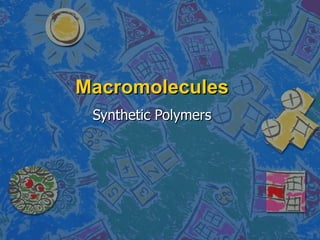Chemistry Macromolecules
•Descargar como PPT, PDF•
17 recomendaciones•24,076 vistas
Denunciar
Compartir
Denunciar
Compartir

Recomendados
Más contenido relacionado
La actualidad más candente
La actualidad más candente (20)
Similar a Chemistry Macromolecules
Similar a Chemistry Macromolecules (20)
Último
Último (20)
TrustArc Webinar - Stay Ahead of US State Data Privacy Law Developments

TrustArc Webinar - Stay Ahead of US State Data Privacy Law Developments
Apidays New York 2024 - The value of a flexible API Management solution for O...

Apidays New York 2024 - The value of a flexible API Management solution for O...
Axa Assurance Maroc - Insurer Innovation Award 2024

Axa Assurance Maroc - Insurer Innovation Award 2024
Tech Trends Report 2024 Future Today Institute.pdf

Tech Trends Report 2024 Future Today Institute.pdf
Exploring the Future Potential of AI-Enabled Smartphone Processors

Exploring the Future Potential of AI-Enabled Smartphone Processors
From Event to Action: Accelerate Your Decision Making with Real-Time Automation

From Event to Action: Accelerate Your Decision Making with Real-Time Automation
Boost PC performance: How more available memory can improve productivity

Boost PC performance: How more available memory can improve productivity
Strategize a Smooth Tenant-to-tenant Migration and Copilot Takeoff

Strategize a Smooth Tenant-to-tenant Migration and Copilot Takeoff
[2024]Digital Global Overview Report 2024 Meltwater.pdf![[2024]Digital Global Overview Report 2024 Meltwater.pdf](data:image/gif;base64,R0lGODlhAQABAIAAAAAAAP///yH5BAEAAAAALAAAAAABAAEAAAIBRAA7)
![[2024]Digital Global Overview Report 2024 Meltwater.pdf](data:image/gif;base64,R0lGODlhAQABAIAAAAAAAP///yH5BAEAAAAALAAAAAABAAEAAAIBRAA7)
[2024]Digital Global Overview Report 2024 Meltwater.pdf
Powerful Google developer tools for immediate impact! (2023-24 C)

Powerful Google developer tools for immediate impact! (2023-24 C)
AWS Community Day CPH - Three problems of Terraform

AWS Community Day CPH - Three problems of Terraform
HTML Injection Attacks: Impact and Mitigation Strategies

HTML Injection Attacks: Impact and Mitigation Strategies
Tata AIG General Insurance Company - Insurer Innovation Award 2024

Tata AIG General Insurance Company - Insurer Innovation Award 2024
ProductAnonymous-April2024-WinProductDiscovery-MelissaKlemke

ProductAnonymous-April2024-WinProductDiscovery-MelissaKlemke
Strategies for Landing an Oracle DBA Job as a Fresher

Strategies for Landing an Oracle DBA Job as a Fresher
Chemistry Macromolecules
- 2. Macromolecules s Macromolecules are large molecules built up from many small repeating units (monomers) joined together by covalent bonding s Different macromolecules are made up of different units and/or different linkages s Generally, 2 types of macromolecules – synthetic and natural
- 3. Definitions s A monomer is a small molecule that may be covalently bonded to other monomers to form a polymer s A polymer is the macromolecule formed when monomers are covalently bonded to form a long chain of molecule s Polymerisation is the process whereby a large number of small molecules (monomers) join together to form a macromolecule
- 4. Synthetic polymers s Polyethene s Polyvinyl chloride s Teflon s Polystyrene s Perspex s Nylon s Terylene
- 5. Addition Polymerisation s Addition polymerisation occurs when monomer units join together by breaking double or triple bonds without losing any molecules or atoms s Eg. Alkenes undergo addition polymerisation whereby the double bonds in alkenes are changed to single bonds
- 6. Formation of polyethene from ethene n can be between 10 000 and 30 000
- 7. More addition polymers Name & formula of Name & formula of monomer polymer Propene Polypropene Chloroethene Polychloroethene (vinyl chloride) Polyvinyl chloride Tetrafluoroethene Polytetrafluoroethene Teflon Phenylethene Polyphenylethene Styrene Polystyrene
- 8. Condensation Polymerisation s Condensation polymerisation occurs when monomer units join together by eliminating a small molecule, like water, to produce a polymer s 2 main types of condensation polymers – polyamides and polyesters
- 9. Formation of Nylon s Made from dicarboxylic acid and diamine H-O O-H H H AMIDE LINKAGE –CONH –
- 10. Formation of Terylene s Made from dicarboxylic acid and diol s Benzene-1,4-dicarboxylic acid and ethane-1,2-diol H-O O-H H H ESTER LINKAGE –COO –
- 11. Uses of synthetic polymers Name Uses Polyethene To make plastic bags, cling film Nylon To make clothing, fishing line, parachutes Terylene To make clothing PVC To make insulator for cables, plastic raincoats Polystyrene To make polystyrene disposable boxes, light-weight packaging Teflon For coating cooking utensils
- 12. Pollution caused by non- biodegradable plastics s Plastics are relatively cheap, easily shaped s Light, tough, waterproof and durable s However, cannot be decomposed by bacteria in the soil s Disposal usually by burning, and possibly produce poisonous gases s Biodegradable plastics are required to solve the problems
- 14. Examples of natural macromolecules s Proteins s Fats s Carbohydrates s They are the main constituents of food but with different units
- 15. Proteins s Built up from units of amino acids s Proteins have the same amide linkages as nylon but with different units
- 16. Fats and Oils s Built up from glycerol and long-chain carboxylic acids (fatty acids) s Fats are esters possessing the same ester linkages as Terylene but with different units